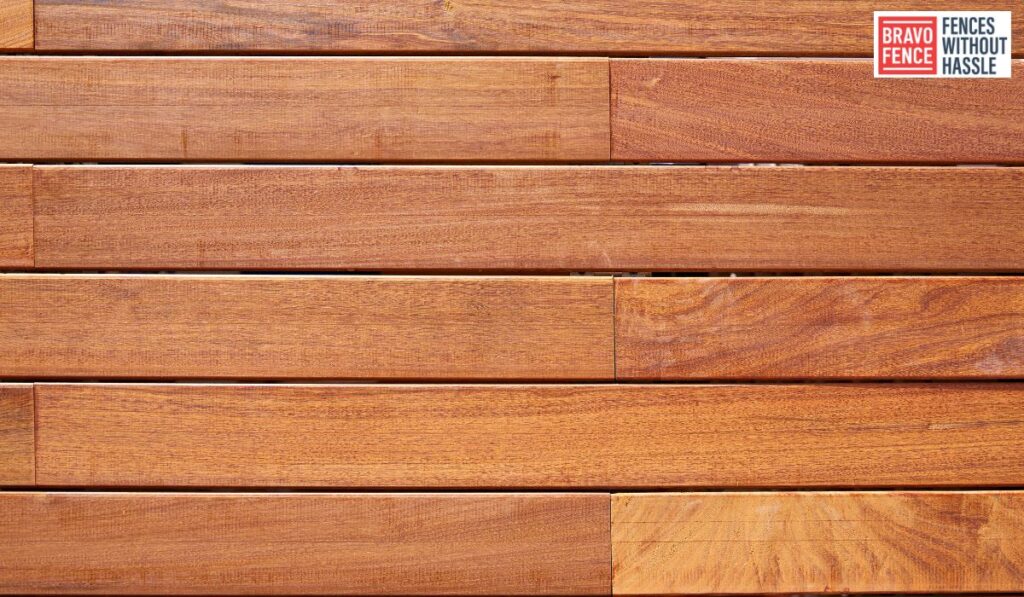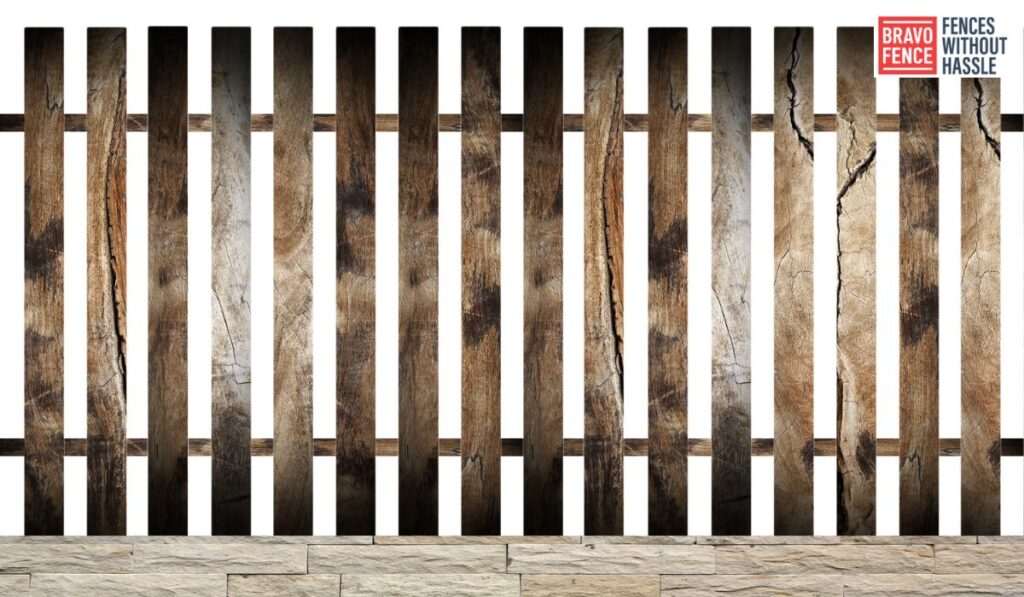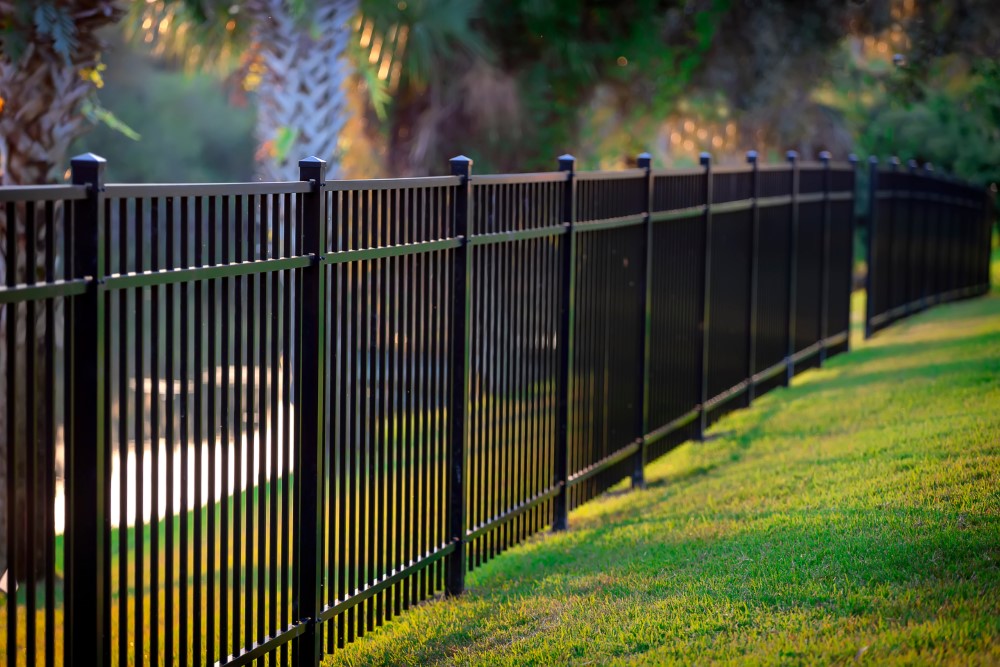
Horizontal Wood Fence Designs & Styles To Consider In 2023
If you’re looking to spruce up your outdoor space and add some privacy, a horizontal wood fence may be just what you need.
Horizontal wood fences have been gaining popularity in recent years, and 2023 is no exception.
With their sleek and modern design, they’re a great option for anyone looking to upgrade their yard.
Whether you’re looking for a simple board-on-board design or something more intricate and eye-catching, there are plenty of horizontal wood fence ideas to consider.
The most popular look remains the horizontal board-on-board with classic post caps, but there are plenty of other options, such as semi-privacy or even pickets.
Consider adding a top rail, lattice, or trellis for something extra special.
Read on for all you need to know about horizontal wood fence designs and styles in 2023!
Why Horizontal Wood Fence Designs Are A Big Hit In 2023
Horizontal wood fences have become increasingly popular due to their contemporary and stylish look.
They can complement any outdoor area and provide a unique touch to your home’s overall appearance.
Furthermore, horizontal wood fences are versatile and can be customized to match any personal style and preference.
Whether you prefer a rustic, modern, or classic look, there are plenty of horizontal wood fence designs to choose from.
The installation process is also straightforward and can be done in a short amount of time.
How Does A Horizontal Wood Fence Differ From A Vertical Fence?
The main difference between horizontal and vertical wood fences is the orientation of the boards.
Vertical fences have boards that run up and down, while horizontal fences have boards that run side to side.
The design of the horizontal fence creates a more open, modern, and spacious feel while providing excellent privacy.

Horizontal fences are also easier to install than vertical fences and require less maintenance.
The boards are held together with horizontal rails, making them less likely to break or warp over time.
Plus, they look great no matter the season and come in a range of materials such as cedar, redwood, pine, and more.
Pros And Cons Of Installing A Horizontal Wood Fence
Let’s consider some pros and cons of installing a horizontal wood fence on your property.
Pros:
- Adds a modern and stylish look to your home: Horizontal wood fences are sleek, contemporary, and eye-catching.
They can add a unique touch to your outdoor area and create the perfect backdrop for outdoor activities. - Provides excellent privacy and security: Horizontal wood fences can provide the privacy and security that you need while still maintaining an open, airy feel.
- Low maintenance requirements: Horizontal fences are easy to clean and require minimal maintenance.
- Can be customized to match your personal style: With a horizontal wood fence, you can choose the type of boards, posts, and hardware that best match your personal style.
- Allows for more light and airflow: Horizontal wood fences allow more light and airflow than vertical fences, making them the perfect choice for those who want to keep their outdoor space open.
Cons:
- Higher installation costs due to additional materials: Horizontal wood fences require more materials and labor than vertical fences, which can make them a bit pricier.
- Less wind protection: Horizontal wood fences can provide some wind protection, but not as much as vertical fences.
- Requires frequent staining and sealing to prevent damage: Yes, but this is true of any wood fence!
- May require professional installation: Depending on the complexity of your fence design, you may need a professional to install it for you.
Types Of Horizontal Wood Fences
Split-rail fences, shadowbox-style fences, picket fences, and privacy panels on battens are all popular types of horizontal wood fences.
Each style provides a unique look and feel to your yard.
Split-rail fences
Split-rail fences are the simplest type of horizontal fence, consisting of horizontal rails between vertical posts.
The horizontal rails are usually spaced apart, creating an open and airy feel.
Shadowbox-style fences
Shadowbox-style fences feature alternating panels, with each panel overlapping the previous one.
This creates a slatted design that allows light and air to pass through.
This type of fence provides both privacy and airflow while still looking stylish.
Picket fences
Picket fences have vertical pickets attached to horizontal rails, while privacy panels on battens are solid panels that offer maximum privacy.
Both styles are available in a range of materials and colors, so you can choose the right one to match your home.

Is Wood The Only Option For Horizontal Fencing?
No, wood is not the only option for horizontal fencing.
While wood is a popular choice due to its natural beauty and durability, there are other materials that can be used for horizontal fencing.
Some alternative options include composite materials, metal, vinyl, and bamboo.
These materials can offer unique design possibilities and may have different advantages and disadvantages compared to wood, such as lower maintenance requirements or increased durability.
It’s important to work with a reputable fence contractor like Bravo Fence Company to help you choose the best material for your specific needs and preferences.
How To Build A Horizontal Fence?
Building a horizontal wood fence requires a bit of preparation and some DIY skills.
Here are the basic steps to get started:
- Prepare the site and dig postholes
- Install the posts and rails (or boards)
- Connect top and bottom railings or boards
- Secure the posts with concrete
- Attach boards or panels to the frame
- Add decorative features, if desired
Of course, if you aren’t experienced with this sort of construction, or you don’t have the tools and supplies, give us a call! Bravo Fence Company designs and installs beautiful, custom horizontal fences.
Maintenance Tips For Horizontal Fences
A well-designed and well-built horizontal fence can add a stunning visual appeal to any property.
Whether you’ve installed a beautiful cedar or redwood fence or you’ve chosen a low-maintenance composite material, it’s important to take care of your fence to ensure it lasts for years to come.
One of the key aspects of maintaining a horizontal fence is to keep it clean. Dirt, dust, and debris can accumulate on the surface of the fence, causing discoloration or even mildew growth.
To clean your fence, start by removing any loose debris with a broom or brush.
Then, use a garden hose or pressure washer to rinse the surface of the fence.
If necessary, use a mild soap or fence cleaner to remove any stains or grime.
Another essential aspect of maintaining a horizontal fence is to keep it well-sealed.
Sealing the wood can protect it from moisture, which can cause warping or rotting over time.
To seal your fence, start by sanding any rough spots or splinters on the surface.
Then, apply a high-quality sealant or stain to protect the wood from the elements.
Lastly, it’s important to inspect your horizontal fence regularly for any signs of damage or wear.
Check for loose boards or rails, rotting wood, or signs of insect infestation.
If you notice any issues, it’s best to address them as soon as possible to prevent further damage.
Overall, with regular cleaning, sealing, and maintenance, a horizontal fence can add beauty and value to your property for years to come.
By taking good care of your fence, you can enjoy its stunning aesthetic and functional benefits for many years to come.
Horizontal Fence Design – Top Picks Of 2023
In 2023, the top picks for horizontal fence design include a combination of modern and rustic styles.
One popular trend is using reclaimed wood to create a rustic and eco-friendly fence.
Another popular trend is incorporating metal accents into the design, such as metal posts or metal paneling.
For a more modern look, consider using composite materials for the fence boards and posts.
Regardless of style, horizontal wood fences are an excellent way to add privacy, security, and visual appeal to any outdoor space.
If you’re thinking of installing a horizontal wood fence, it’s important to consider your budget, design preferences, and local climate conditions.
A qualified fence contractor, like our team at Bravo Fence Company, can help you choose the best materials and design for your project.
With the right design and materials, your horizontal wood fence will last for years to come.
Choosing Bravo Fence Company For Your Horizontal Fencing Needs
If you’re not confident in your DIY skills or don’t have the time to build a horizontal fence yourself, consider hiring a professional fencing company like Bravo Fence.
Our team of experts can help you choose the perfect design, materials, and installation options for your specific needs.
With years of experience and a commitment to quality, Bravo Fence can help you transform your outdoor space into the backyard oasis of your dreams.
FAQs
Q: Are horizontal wood fences more expensive?
A: Horizontal wood fences can be more expensive due to the additional materials and labor required for installation. However, the cost can vary depending on the type of wood used, the design of the fence, and the size of the project.
Q: What kind of wood should I use for a horizontal fence?
A: The type of wood you use for your horizontal fence depends on your budget, personal preferences, and local climate conditions. Some popular options include cedar, redwood, and pressure-treated pine.
Q: Is it cheaper to do a horizontal or vertical fence?
A: The cost of a horizontal or vertical fence depends on various factors, such as the type of wood, design, and labor costs. However, horizontal fences can be more expensive due to additional materials and installation complexity.
Q: Do horizontal or vertical fences last longer?
A: The lifespan of a fence depends on the quality of materials, installation, and maintenance. Generally, both horizontal and vertical fences can last for several years with proper care.
Q: Do horizontal fences need gaps?
A: Yes, horizontal fences need gaps to allow for air and moisture flow. Without gaps, the fence boards can warp, twist, or cup.
Q: Do you need to leave a gap between horizontal fence boards?
A: Yes, leaving gaps between horizontal fence boards is essential to allow for air and moisture flow, prevent warping, and ensure the longevity of the fence.
Q: How far apart should fence posts be for a horizontal fence?
A: The spacing between fence posts for a horizontal fence depends on the size of the fence panels, wind load, and the type of wood used. Typically, fence posts should be spaced no more than 8 feet apart.
Q: How do you keep a horizontal fence from sagging?
A: To prevent a horizontal fence from sagging, make sure to use sturdy materials and proper installation techniques. This includes using strong posts, horizontal rails or boards, and ensuring the fence is level during installation.
Q: How many boards do I need for a horizontal fence?
A: The number of boards needed for a horizontal fence depends on the size of the project, the width of the boards, and the spacing between each board. Your fence contractor can help you determine the number of boards needed for your specific project.
Q: How wide should horizontal fence boards be?
A: The width of horizontal fence boards can vary depending on personal preference, design, and structural requirements. Common widths range from 4 to 8 inches, but your fence contractor can help you choose the appropriate size for your project.
Tags: Complete Guide to Woodfencing, Explore Helpful Resources on Gardenfence, Explore Helpful Resources on Modernfencing, Explore Helpful Resources on Outdoordesign, Inspiration and Tips on Contemporaryfencing, Inspiration and Tips on Horizontalwoodfence, Inspiration and Tips on Propertyenhancement, Top Ideas and Insights About Backyardfence, Top Ideas and Insights About Fenceinstallation, Top Ideas and Insights About Privacyfence
